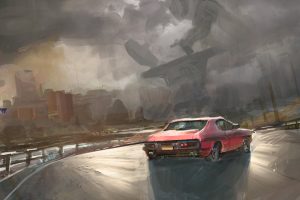As Neall would say: Greetings, true believers! Meghan here, to share with you a high-level preview of what’s going into Scion: Mysteries of the World, the companion book to Origin and Hero. Remember that the book is still in first drafts, so anything and everything is subject to change! But this is what Neall and I have worked out for the outline, and what the writers are currently busy working on.
Chapter One: Myth Level
The Myth Level is five options along four axes of design, meant to allow the Storyguide to choose how many of Scion’s setting “dials” they want to crank. This chapter lays out what each of those dials looks like at each of the five Myth Levels. Those Myth Levels are:
- Iron: Perfectly mundane. Very similar in nature and tone to Gaiman’s American Gods, where ifriti are cab drivers, Odhinn is a shiftless wandering con man, and Chernobog and the goddesses of dawn, midday and evening are poor immigrants scraping by in a shitty apartment in Chicago.
- Heroic: Mostly mundane, but with room for great acts of heroism. Most supernatural creatures still have mundane manifestations here (that centaur is still just a biker here), but Scions and gods may appear as impressive and tremendous – Aphrodite isn’t some burnt out barfly here, she’s drop-dead gorgeous and probably on fashion covers. This is the level of the Iliad and the Odyssey.
- Bronze: This is where the supernatural really comes into play. Creatures of Legend shed their mundane disguises in areas of Bronze Myth, and appear in their true nature. Magic becomes overt here, and Demigods wield their true power. This is Clash of the Titans territory, and there might just actually be dragons in that undetailed area of the map.
- Silver: Past the threshold of urban myth and getting into epic fantasy, places of Silver Myth are deeply resonant with Myth. They are often fanciful places and hidden vales of magic technically found in the World, but not of it. The power of a creature of Legend is reflected in its appearance – the mightier the entity, the more impressive it appears. Zelazny’s Lord of Light goes into this area of Myth in its narrative.
- Gold: Flat-out mythological, where symbolism is the same as its reality. Places of Gold Myth are not even of this World. Lots of Scion 1e went into this territory, with its otherworldly locales, and lots of fantasy that touches on extradimensional areas and the like qualify.
The trick is this: you should be able to choose a starting Myth Level and then turn each dial up or down within that level to taste. So, for instance, as Storyguide I might choose to start at the Iron Level but crank the Titanomachy up, turning American Gods into a raging shadow war that you have to keep peeling back layers of the World to see.
Chapter Two: Cults
This chapter covers mortal interactions with Scions. We’re drilling down on both a Hero’s function as intermediary with the divine, and the propensity of people to directly worship the Scion.
One of the main questions we get is, “What do Scions do?” and the answer is, besides fighting monsters, they intercede between humans and the divine and act as mortal champions — as people at the forefront of societies. This causes Hero cults to form around our protagonists, small offshoots of their parent’s cult and the larger faith. These can get borderline heretical and nearly to the level of cults of personality, with various people assuming positions of importance to the cult and the Scion.
We’ll also have a basic system for how the cults — a new type of Birthright — can do things for the Scion and vice versa. This includes creating a cult and its SG characters: prominent positions, roles, and the like.
Chapter Three: Pantheons
First, we’ll present the Loa, to update the Gods who weren’t carried over into Hero’s Òrìshà Pantheon, and depict how the practice of Voudoun differs from the religion and practices there.
Next, we’ll give a full Pantheon write-up for the Nemetondevos, the lost (but to be once again found) Gods of Gaul. The Nemetondevos were, as a Pantheon, destroyed by Julius Caesar after his progression to Demigod and as part of the Deeds he performed to earn his apotheosis. Several Gods and many of their Scions were slain, their followers enslaved and put to the sword, their shrines upon the nemetons broken and destroyed. Some managed to flee and survive Caesar’s wrath. The others retreated to the Gaulish Underworld, Dubnolissos, where they licked their wounds and awaited the wheel of reincarnation to return them to the World.
Then, a full 2e write-up for the Yazata: the Zoroastrian Gods of Persia. Because their Gods are pretty much all dedicated to upholding the idea of fighting as the Side of Good against the Forces of Evil, they have a much higher per-capita representation of concepts like righteousness and holiness, justice and law, and purity that fights corruption. They also equate righteousness with truth, so anything that is true is righteous and good, and anything that is a lie is evil and contemptible.
Finally, this chapter will give one additional God write-up for each of the 10 Pantheons in Hero, and talk a bit more about Mantles and how they manifest.
Chapter Four: Pantheon Creation
This chapter does two things: presents rules for how to create your own Purviews, including some samples, and then walks the reader through a Pantheon creation exercise using the fictional Gods of Atlantis as an example.
Chapter Five: Expanded Relics
This chapter does a few things: expands the crafting rules from Origin and the relic design rules from Hero with more advice; walks through a more detailed in-character process for creating relics, including using the Forge Purview to do so and examples of what its Marvels can do in crafting; and presents detailed play examples. We’ll also have a few new example relics.
Chapter Six: Translation Guide
This chapter focuses on how to translate elements of Scion 1st Edition into 2e, including creating a character in the new system from an established character, with examples; and addressing system and setting changes, like creating new Purviews from the rest of the Epic Attributes and discussing the revised role of Fate and Titans in the World.


Comments
4 responses to “Mysteries of the World [Scion 2e]”
Very interesting, I hope we get a blog post like this for Oak, Ash, and Thorn: Changeling Companion as well.
This sounds like a great book all-around!
I’m always in favor of a translation guide any time a game changes editions/mechanics. It makes using existing material easier and lets the creators focus on new ideas.
Is this the book that will also discuss tutelary deities, and making new more specific Purviews?
I believe so yes